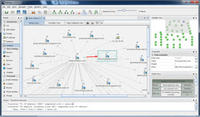-
Kansas history says DHS opened his mail -- again
Grant Goodman, a retired professor at the University of Kansas, was shocked when he found out that DHS opened his mail in 2005, but now that it has happened again, he just wants to know why; CBP does not need a warrant or probable cause to check international mail or cargo
-
-
DARPA seeking surveillance technology to predict future behavior
DARPA has teamed up with scientists from Carnegie Mellon University to create an artificial intelligence system that can watch and predict what a person will “likely” do in the future, using specially programmed software designed to analyze various real-time video surveillance feeds; the system can automatically identify and notify officials if it recognized that an action is not permitted, detecting what is described as anomalous behaviors
-
-
Searching social media sources by geography
Geofeedia, has created a group of algorithms that can search multiple social media sources by geography in real time; the postings, pictures, and tweets that show up in the results of a search are geolocation-enabled, are free, and results can be streamed on a mobile device, computer, or tablet. Businesses may have to pay a fee for more intensive searches
-
-
CIA-commissioned climate change report outlines perils for U.S. national security
U.S. national security leaders believe that the accelerating pace of climate change will place severe strains on U.S. military and intelligence agencies in coming years; the reason, according the National Research Council, the U.S. top scientific research body: climate changes will trigger increasingly disruptive developments around the world; a 206-page National Research Council study, commissioned by the CIA and other U.S. intelligence services, concludes that states will fail, large populations subjected to famine, flood, or disease will migrate across international borders, and national and international agencies will not have the capacity or resources to cope with the resulting conflicts and crises
-
-
New cell phone surveillance method raises privacy concerns
The FBI is using a new method to access cell phone customer data,butthe American Civil Liberties Union (ACLU) contends that the method is overly invasive
-
-
Smart camera to describe what it sees -- and reason about what it cannot see
Army scouts are commonly tasked with covertly entering uncontrolled areas, setting up a temporary observation post, and then performing persistent surveillance for twenty-four hours or longer; what if instead of sending scouts on high-risk missions the military could deploy taskable smart cameras? A truly “smart” camera would be able to describe with words everything it sees and reason about what it cannot see
-
-
New app uses scattered public information to put together a digital footprint of individuals, organizations

A new app application can collect scattered online clues to provide a picture of individuals or organizations; the application draws on public data sources in order to put together a graphical digital footprint
-
-
Scenario-based gaming exercise to improve intelligence analysis
Raytheon has created a scenario-based gaming exercise to study in depth the intelligence analyst’s tradecraft; the company says the goal is ultimately to help analysts produce the best intelligence products and streamline workflows
-
-
Senate panel’s report harshly criticizes role, utility of DHS fusion centers
A 2-year bipartisan investigation by the U. S. Senate Permanent Subcommittee on Investigations has found that DHS efforts to engage state and local intelligence “fusion centers” has not yielded significant useful information to support federal counterterrorism intelligence efforts; the report says that senior DHS officials were aware of the problems hampering effective counterterrorism work with the fusion centers, but did not always inform Congress of the issues, nor ensure the problems were fixed in a timely manner; DHS estimates that it has spent somewhere between $289 million and $1.4 billion in public funds to support state and local fusion centers since 2003 (the report says that these are broad estimates which differ by over $1 billion); the Senate investigation raises questions about the value this amount of funding and the contribution the fusion centers make to the U.S. counterterrorism efforts; not everyone agrees with the report; Rep. Peter King (R-NY), chairman of the House Committee on Homeland Security, said: “I agree with Chairman Joe Lieberman and Ranking Member Susan Collins [of the Senate Committee on Homeland Security] that the subcommittee report issued this week paints with too broad a brush an incomplete picture that fails to recognize many of the important contributions that fusion centers have made in securing our Homeland”
-
-
Future of interrogation methods of terrorists may depend on election
On the campaign trail, Barack Obama and Mitt Romney have not said much about their approach to interrogating terrorists; but as the manner in which U.S. government agencies approach such interrogations, and the practices agents employ, may well depend on the outcome of next month’s election
-
-
DHS focus on suspicious activity at critical infrastructure facilities
Federal, state, and local law enforcement let people know that if theytake pictures or notes around monuments and critical infrastructure facilities, theycould be subject to an interrogation or an arrest; in addition to the See Something, Say Something awareness campaign, DHS also has broader initiatives such as the Buffer Zone Protection Program, which teach local police and security how to spot potential terrorist activities
-
-
Critics: U.S. not doing enough to combat domestic terrorism

The effectiveness of the U.S. campaign against al Qaeda and its affiliates may have reduced the threat of foreign terrorists launching attacks on targets in the United States, but the threat of terrorism the United States is facing has not been reduced owing to the rise in domestic terrorism
-
-
LAPD wants to know why you are taking these photos
If you live in Los Angeles and decide to take some pictures of a few monuments or public places to send to friends and family or for your own private collection, the Los Angeles Police Department (LAPD) may see you as a potential threat to public safety
-
-
German police wants to develop its own computer surveillance software
The Federal Police Office of Germany (also known as the BKA) is looking to hire software engineers who can develop computer surveillance technology for use by law enforcement and intelligence agencies in criminal investigations
-
-
Threat-recognition technology incorporates mind, machine

For soldiers operating in the field, the ability to detect threats from standoff distances can be life-saving; when advanced radar and drone coverage is not available, soldiers typically rely on their own vision to scan their surroundings; DARPA links human brainwaves, improved sensors, and cognitive algorithms to improve target detection
-
- All
- Regional
- Water
- Biometrics
- Borders/Immig
- Business
- Cybersecurity
- Detection
- Disasters
- Government
- Infrastructure
- International
- Public health
- Public Safety
- Communication interoperabillity
- Emergency services
- Emergency medical services
- Fire
- First response
- IEDs
- Law Enforcement
- Law Enforcement Technology
- Military technology
- Nonlethal weapons
- Nuclear weapons
- Personal protection equipment
- Police
- Notification /alert systems
- Situational awareness
- Weapons systems
- Sci-Tech
- Sector Reports
- Surveillance
- Transportation
Advertising & Marketing: advertise@newswirepubs.com
Editorial: editor@newswirepubs.com
General: info@newswirepubs.com
2010-2011 © News Wire Publications, LLC News Wire Publications, LLC
220 Old Country Road | Suite 200 | Mineola | New York | 11501
Permissions and Policies
Editorial: editor@newswirepubs.com
General: info@newswirepubs.com
2010-2011 © News Wire Publications, LLC News Wire Publications, LLC
220 Old Country Road | Suite 200 | Mineola | New York | 11501
Permissions and Policies
